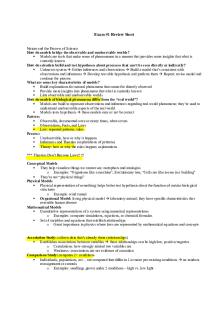Accounting 201 Exam 1 Review PDF

| Title | Accounting 201 Exam 1 Review |
|---|---|
| Course | Financial Accounting I |
| Institution | University of Kentucky |
| Pages | 3 |
| File Size | 84.3 KB |
| File Type | |
| Total Downloads | 63 |
| Total Views | 159 |
Summary
Notes for exam 1...
Description
Accounting 201 Exam 1 Review and Practice Questions The Accounting Equation o Assets (DR) = Liabilities (CR) + Owners’ Equity (CR) Owners’ Equity = Common Stock (CR) + Retained Earnings (CR) Retained Earnings = Net Income (CR) – Dividends (DR) o Dividends = Revenue (CR) – Expenses (DR) Assets: Resources owned by a company Liabilities: Amount owed to a creditor Owners’ Equity: The stockholders’, or owners’ claim to resources, which equal the difference between total assets and total liabilities Steps in the Measurement Process o Analyze Transactions o Create Journal Entries o Post Entries to General Ledger o Create Unadjusted Trial Balance o Adjusted Journal Entries o Create Adjusted Trial Balance o Create Financial Statements o Create and Post Closing Entries o Create and Post Closing Trial Balance Financial Statements: o Service Revenue appears on Income Statement o Equipment appears on Balance Sheet o Advertising Expense appears on Income Statement o Accounts Receivable appears on Balance Sheet o Common Stock appears on Balance Sheet o Interest Payable appears on Balance Sheet Answers from Exam 1 Practice: Accounting is an information system that provides reports to users regarding economic activities and condition of a business. Examples of internal users of accounting are: o Employees o Managers. Examples of external users of accounting are: o Government o Creditors o Customers Examples of business entities are: o Proprietorship o Partnership o Corporation A corporation is most likely to obtain large amounts of resources by issuing stock.
The unit of measure concept: o Requires that economic data be reported in yen in Japan or dollars in the United States Assets are financed by owners and/or creditors. Debts owed by a business are referred to as a liability. Example: o Assets: $128,000 o Liabilities: $84,000 o Stockholders’ Equity: $128,000 - $84,000 = $44,000 If a business pays a creditor $7,000, it would decrease an asset and decrease a liability. Accounts with a normal credit balance: o Liabilities o Common Stock o Retained Earnings o Net Income o Revenue Accounts with a normal debit balance: o Assets o Dividends o Expenses Type of entries that record the payment of an account payable: o Debit Account Payable o Credit Cash Type of entries that record the cash sale of capital stock to stockholders: o Debit Cash o Credit Capital Stock Journalizing is the process of initially recording a business transaction. Type of entry that records the purchase of office supplies on account: o Debit Office Supplies o Credit Accounts Payable Type of entry that records the payment of rent for the current month: o Debit Expense o Credit Cash Type of entry that records the collection of cash from customers: o Debit Cash o Credit Fees Earned An entry that records the receipt of cash for two months’ rent (advance of providing the service): o Debit Cash o Credit Unearned Rent Purchase equipment for $7,500, paid $2,250 with the remainder to be paid later: o Equipment: $7,500 o Accounts Payable: $5,250
o Cash: $2,250 Accounts that increase with a credit: o Accounts Payable o Unearned Revenue o Capital Stock Payment for monthly rent requires the entries: o Debit Rent Expense o Credit Cash Prepaid Expense: o Account Type: Asset o Normal Balance: Debit Unearned Revenue: o Account Type: Liability o Normal Balance: Credit...
Similar Free PDFs

Accounting 201 Exam 1 Review
- 3 Pages

Accounting Exam 1 Review
- 3 Pages

Accounting 1 Final Exam Review
- 15 Pages

Bio 201 Exam 2 Review
- 11 Pages
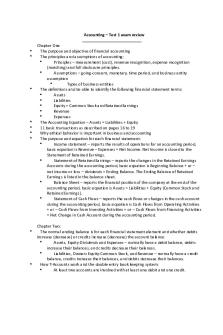
Accounting – Test 1 exam review
- 2 Pages
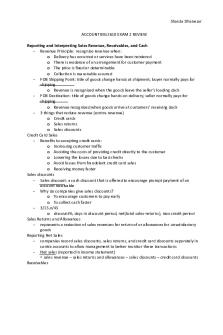
Accounting Exam 2 Review
- 10 Pages

Accounting Exam 2 Review
- 17 Pages
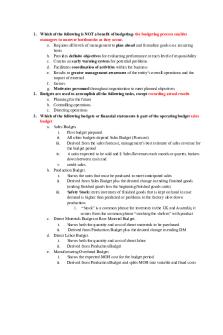
Accounting Exam 2 Review
- 8 Pages

APHY 201 Exam 3 Review copy
- 3 Pages

Accounting 1 Exam 2 Review notes
- 21 Pages
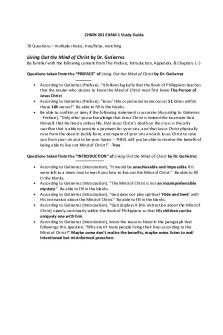
CHMN 201 Exam 1 Guide
- 6 Pages

ECON 201 Exam 3 review solutions
- 7 Pages

Ch9 accounting 201 assignment
- 101 Pages
Popular Institutions
- Tinajero National High School - Annex
- Politeknik Caltex Riau
- Yokohama City University
- SGT University
- University of Al-Qadisiyah
- Divine Word College of Vigan
- Techniek College Rotterdam
- Universidade de Santiago
- Universiti Teknologi MARA Cawangan Johor Kampus Pasir Gudang
- Poltekkes Kemenkes Yogyakarta
- Baguio City National High School
- Colegio san marcos
- preparatoria uno
- Centro de Bachillerato Tecnológico Industrial y de Servicios No. 107
- Dalian Maritime University
- Quang Trung Secondary School
- Colegio Tecnológico en Informática
- Corporación Regional de Educación Superior
- Grupo CEDVA
- Dar Al Uloom University
- Centro de Estudios Preuniversitarios de la Universidad Nacional de Ingeniería
- 上智大学
- Aakash International School, Nuna Majara
- San Felipe Neri Catholic School
- Kang Chiao International School - New Taipei City
- Misamis Occidental National High School
- Institución Educativa Escuela Normal Juan Ladrilleros
- Kolehiyo ng Pantukan
- Batanes State College
- Instituto Continental
- Sekolah Menengah Kejuruan Kesehatan Kaltara (Tarakan)
- Colegio de La Inmaculada Concepcion - Cebu


